Introduction
With 2.45 billion monthly visits, Amazon is far and away the leading ecommerce platform. But even with the massive level of traffic, the marketplace is intensely competitive.
Amazon PPC gives sellers the opportunity to get eyes on their listings and pull ahead of their competitors — if you know how to use it.
In this post, you’re going to learn exactly how to create and optimize effective Amazon PPC campaigns step-by-step.
Keep in mind sales velocity is one of the most important factors in Amazon’s ranking algorithm. So the more you sell, the higher you rank.
In fact, this approach has helped us to grow our client sales and ROI every month.
What Is Amazon PPC?
Amazon PPC (also referred to as “Amazon Pay-Per-Click”) is the process of advertising products on the Amazon platform.
Millions of Amazon customers are searching for products daily. They click on the search bar and type their desired product or keyword, then advertisers on the relevant keyword/search phrase will play into a digital auction. The advertiser with the highest bid will win the auction, and their product ads will be visible to the customer.
Advertisers are in an auction and only pay the bid price if their ad gets clicked.
Amazon PPC is a pay-to-play game.
With that, let’s look at the pieces that go into an Amazon PPC campaign.

Amazon PPC Campaign Structure
When you are creating your Amazon PPC campaigns make sure you segment them by stage. Usually we run campaigns for research in which we are looking for new keywords and in the same time we run production campaigns that are for proven to work keywords. In the research campaigns always exclude the keywords that you are targeting in the production campaigns.
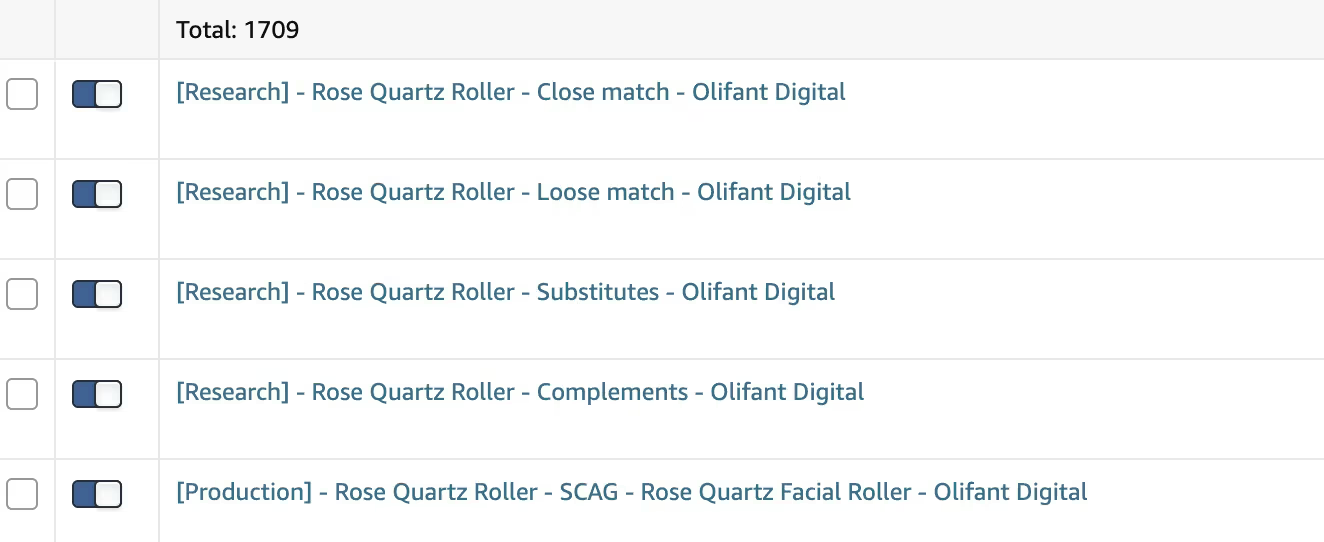
You need to be running campaigns for ranking and in the same time campaigns for ROI. Decide which are your target keywords and attack them as hard as you can.
When launching campaigns for a new ASIN we launch sponsored products with exact match targeting on our ideal keywords + targeting all of our competitors that are selling the same product for a higher price or they have less reviews.
So, for example, if your campaign goal is to reach your competitors’ customers, you’ll set up ads with keywords shoppers most often use to find competitors’ listings and by targeting your competitor ASINs.
But it doesn’t end there.
There are multiple ad types and placement options, along with keyword match types. We’ll walk you through each of them.
Amazon Ad Types

When you’re setting up your ads, you’ll need to know which ads are available to you and where they are displayed on the marketplace.
Let’s dive into each format.
SPONSORED PRODUCT ADS

When you’re just starting running ads, Sponsored Product Ads are where you’ll want to focus. Sponsored Product Ads are the ads you’re probably most used to seeing and can show in the search results or on product pages.
Product Ads are the ad format with the most scalability and volume. Even once you’ve advanced to other ad types, most of your budget will stay within Sponsored Product Ads.
Sponsored Products are super valuable because they mix with organic results and increase your share of the search results.
Typically, in our experience, they work profitably if you have done proper keyword research and you are optimizing them frequently.

When you have a detailed keyword research you can be very precise with your ad targeting and make sure you get the highest ROI possible. In the same time you should not be obssesed with your ACOS. Watch your TACOS and keep running ads if your store is growing in the right direction.
SPONSORED BRAND ADS

Sponsored Brand Ads show primarily at the top of Amazon searches, but they can also be displayed to the left of the results or at the bottom of the page.
These advertisements are multi-product displays that highlight your brand logo, headline, and different products of your choice. The purpose of Sponsored Brand Ads is to grow your audience’s awareness of your product lineup.
To use sponsored brand advertisements, the advertiser must be on the Amazon Brand Registry and sell a minimum of three registered products on Amazon.
Because Sponsored Brand Ads don’t blend in with the organic results and are meant more to build recognition, these ads should supplement your other types of advertisements, not replace them.
SPONSORED DISPLAY ADS
Sponsored Display Ads allow you to advertise your products on product and review pages. They are most commonly displayed in the right sidebar on a product page, but you may also notice them at the top of the details page.
Again, though, Sponsored Display Ads are only available to sellers enrolled in the Brand Registry.
With Product Display Ads, you can advertise relevant advertisements on detail pages of similar products and sell related items. Display Ads allow you to extend your reach by showing up to relevant audiences.
You can encourage shoppers to leave the current page and visit your listing by using custom ad visuals and engaging headlines.
Plus, if you use the Sponsored Display Ads, your ads can be shown on external websites targeting visitors who saw your product pages but did not purchase. These ads are often referred to as retargeting ads and are displayed as banner ads across Amazon’s network of owned and partnered sites.

If you have a Registered Brand, you can use a mix of all three types of ads. All other sellers have access to the Sponsored Product Ads.
However, even many Brand Registry sellers succeed with the standard Sponsored Product Ads and just stick with them. Make sure that you have maximized your efforts already with sponsored products before you dive in sponsored brands. Ideally you want to use the video format and target your best-converting keywords that you discovered from sponsored products.
Amazon Ad Placements
We briefly hit on where the different types of ads may be displayed, but let’s further discuss the various placement options and how you can use them to your advantage. Understanding the importance of placement will become vital if you choose to optimize your bidding strategy.
You can learn more about what placements are working for your product by reviewing the placement report in your Seller Account.
TOP OF THE SEARCH RESULTS
As you know, every seller’s goal is to get their product listing on the first page of the search results. The first page of the results is where the vast majority of the sales happen.
So, the benefits of having your listing displayed at the top of the search results are obvious — more eyes on your product.
But the downside is that there is only so much space at the top. Because of this, the top of search results placement may be more costly than other placement options.

REST OF THE SEARCH RESULTS
If you’re looking to get your product listing displayed in the search results, but don’t want to pay the premium, the rest of the search is an option.
Keep in mind that Amazon considers the “rest of search” to be anywhere else within the results, including the second page and beyond. So for highly competitive products with tons of ads, this placement may not be worth your ad spend.
ON THE PRODUCT PAGE
The product page placement is perfect for products that complement a larger product or for products that have been successful in swaying customers away from their competitors.
There are endless product pages across Amazon, so you might find they cost less than the premier top of search placement.

You’ll want to carefully monitor your placement report and note which placements get you the best return for your investment. If you find your ads displayed on a product page perform better than search placement, for example, you can adjust your bids accordingly.
Note that placement modifiers are only available for the top of search and product pages placements.
Amazon Bidding
Bidding is one of the more complex parts of the Amazon PPC process. We’re going to look at it piece by piece to help you understand.
HOW THE AUCTION WORKS
The Cost-Per-Click (CPC) on Amazon will always be different in each auction.
Let’s say, as an example, your auction is “Derma Roller,” and you would like to advertise for this keyword. Each seller selects the maximum bid they’re willing to pay per click.
To win an auction, your bid needs to be competitive. Usually, the highest bidder wins the highest ad position in the auction, but Amazon also considers ad quality when determining the winner.
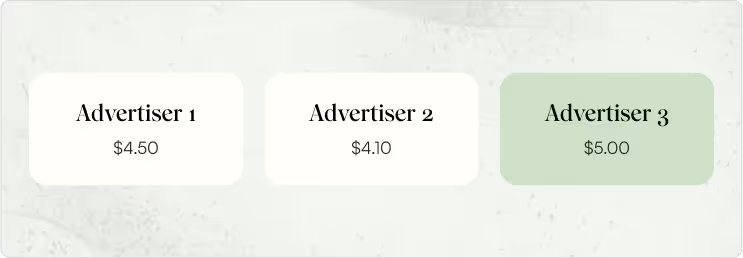
In the example above, advertiser 3 wins the auction since the bid is the highest in that specific auction.
And because Amazon auctions work based on the second price, the winner will only pay $0.01 more than the next highest bid, even if their winning bid was significantly higher.
But be careful with how high you go to win. Some sellers think they can bid well above the recommended bid to secure their spot and encounter another seller with the same strategy, and they end up overpaying per click.
So when advertising on Amazon, it’s essential to play with your bids and try different combinations.
If you are not spending your daily target budget, then I suggest increasing your bids.
If you are spending your daily budget but not getting your desired ROI, I suggest you look at negative keywords, bids, conversion rate, and your product offer.
You have to learn from your data and find where the pipe is broken, and fix it.
AMAZON FEES
What you bid is what you will pay with Amazon PPC. There are no hidden fees from Amazon tacked on after the fact.
Amazon makes their profit when you make your sale, so it’s in their best interest to help you get as many sales as possible.
PLACEMENT BID ADJUSTMENT

As we noted in the previous section, Amazon allows you to adjust your bid based on placement. So while it makes bidding more complex, it can be well worth it to lower your cost per click.
We highly recommend using this feature regularly based on the data. As an Amazon PPC Agency, we find many missed opportunities with our new clients since they weren’t looking at placements frequently.
With a placement modifier, you can adjust your from 0% to 900% based on where it is displayed. So, if you know that ads displayed on product pages for a particular product don’t perform well, you may want to set the bid at 0%. On the other hand, if you have an accessory type of product that does exceptionally well on product pages, you could turn it up to 900%.
Your best bet is to start small, learn, and go from there.
How often should you take a look at your placements? At least one time per week for all of your active campaigns.
When you are optimizing your placements, take a look at the data for the last 7 days, 14 days, 30 days before you make a decision. You have to look and analyze historical data in order to make the best decision for the upcoming weeks and months.
DYNAMIC BIDDING

Another option provided by Amazon is dynamic bidding. Dynamic bidding uses an algorithm to decide how likely a customer is to purchase based on Amazon’s customer data. The algorithm – like all Amazon algorithms – is a secret, so it’s unclear what data Amazon is basing its decision on. But advertisers can use Amazon’s dynamic bidding in coordination with placement modifiers to adjust bids in real-time based on conversion probability.
We are not using this option. If you have a PPC Team, they should not be using it either. Dynamic bidding is dangerous because amazon can increase your bid heavily. As an example, if you bid $1 but you add the dynamic bidding option, then amazon could spend $5 per click instead and ignore your $1 bid. Overall, we see very bad results and big ad-spends with low ROI.
But if you do decide to give it a try, the data needs to be analyzed on a daily, weekly, and monthly basis, and you can base your decisions on it if you are looking for the highest ROI possible.
TYPES OF AMAZON KEYWORDS

You might hear the phrases “search term” and “keyword” used interchangeably, so what is the difference?
For advertising purposes, “search terms” refer to what customers type into the search bar, whereas “keywords” refer to what PPC advertisers bid on.
Depending on the keyword match type (more on this later) used, one keyword could cover multiple search terms.
Match types are likely foreign to you if you haven’t used search advertising before. Let’s look at the match types available on Amazon.
KEYWORD MATCH TYPES
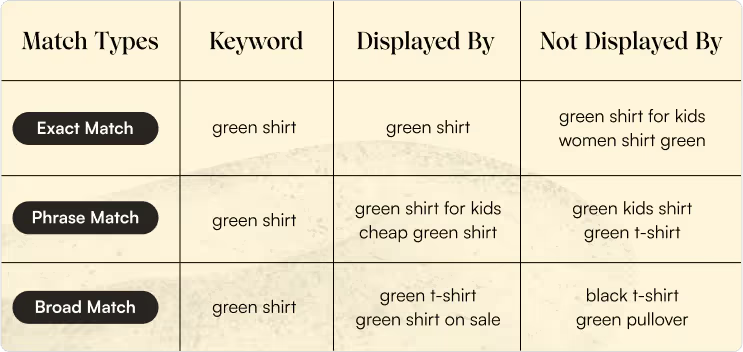
There are three keyword match types — broad, phrase, and exact. The different types will determine what search phrases your ads will show up for.
Broad match keywords show your product ads when a customer searches for that exact keyword, a similar phrase, or even close variations of the keyword.
For example, the broad match keyword “green shirt” could cause your ad to show if someone searches “men’s green shirt” or even “green polo.”
We use broad match keywords for researching new potential keywords that are working well which later on we might add as exact match and target them directly. A big missed opportunity is reviewing search term reports. Usually 9/10 of ad accounts that we audit have that missed opportunity. It’s not about just spending money on PPC. Make sure you analyze your data and you know why you are using specific format.
Another option is phrase match keywords, which will only show your product ads when customer search includes your target keyword phrase.
Again, this is a match type that is for researching on new keyword opportunities that you can target with exact match.
So, if they search for “green shirt for kids,” your ad will show up, but if they search “green 4T boys shirt”, it won’t. Phrase match can help you refine your targeting.
Finally, exact match keywords will show your ads to customers searching exactly the keyword you’re bidding on.
Exact match keywords are the most specific and limit your ads in searches that aren’t relevant. If your exact match keyword is “green shirt for boys,” that is exactly what the shopper needs to end in the search bar. For keywords with +1,000 search volume we isolate exact match keywords in their own campaigns. Make sure you are not missing out on targeting your ideal keywords and watch your TACOS per ASIN not just your ad account ACOS.
NEGATIVE KEYWORD TARGETING
In addition to choosing the best keywords for your ad, you’ll want to add what are called “negative keywords” as well.
Negative keywords are the keywords you do not want your ad to show up for, even if they are related to your term.
Building on the example above, if you have a broad match keyword of “green shirt,” but you don’t want it to show up for “women’s green shirt,” you can add that as a negative keyword.
Negative keywords must be either phrase or exact match keywords. You cannot set a broad match negative keyword.
Why should you use negative keywords? For one, they can help your growth by reducing your ad costs. They also help your ad budget go further because you can use them to remove search terms that are not profitable or unrelated to your product ads.
You can find good negative keywords by reviewing your search terms report. A keyword may need to be added to your negative keywords
If it’s a:
- Low click, non-converting keyword
- High click, non-converting keyword
- High click, high spend keyword
When updated weekly, negative targeting increases your profits.
Make sure you are adding your best-performing keywords from exact match campaigns to negatives in the campaigns that are for research.
AMAZON PPC KEYWORD TARGETING
Amazon AI uses keyword targeting to match customers’ search queries with relevant ads.

Within a controlled PPC campaign (manual campaign), you can refine your ad targeting using the match types that are available:
- Broad/Phrase match type: We love using it for testing purposes when we are still trying to find keywords that are working well.
- Exact match types: We use these two options for proven keywords that meet our target KPI.
So ideally, you want to keep broad/phrase match keywords for testing and exact match for scaling your most profitable keywords.
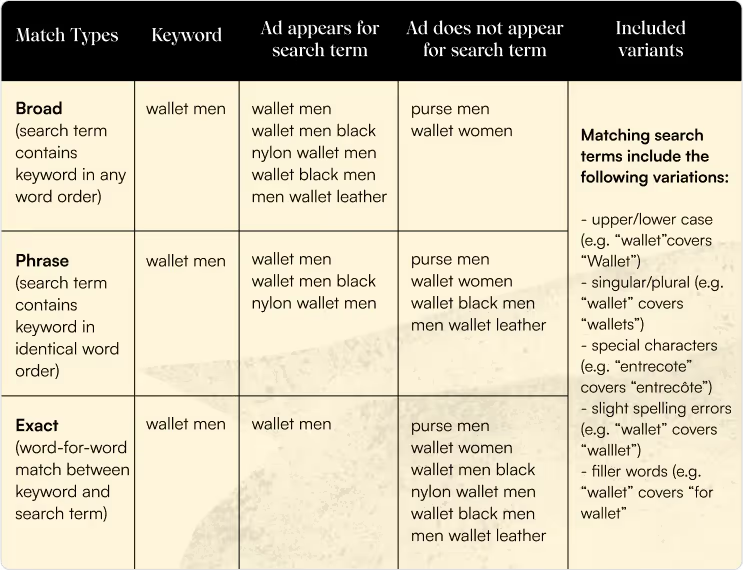
Remember, when setting up your Amazon PPC campaigns, you should create a competitor list of advertisers that are advertising for the same keywords that you want to.
Also, creating a comprehensive Amazon keyword research with different keyword stages.
For example, if you are selling coconut soy candles, advertising for the keyword “candle” might make sense, but if you think about it, you’ll end up advertising with many different kinds of candles, and most of them might be much cheaper.
So you will end up spending your money on the keyword with the most traffic but the lowest conversion rate for your product.
What you could do is attack a keyword like “coconut soy candle,” “coconut candle,” or “soy candle.”
If you are on a limited budget, using long-tail keywords that match your product can work well.
Advanced Ads Targeting Options
If you choose to run automatic campaigns, your targeting options are more limited. Your targeting will be around the keywords in your campaign and how they relate to your product.
The targeting includes:
- Close Match – This will show your ad for search terms closely related to your product listing.
- Loose Match – This will expand the search terms your ad is shown for to items that Amazon can loosely relate to your listing.
- Substitutes – This will cause Amazon to show your ad to shoppers who’ve looked at similar product pages.
- Compliments – This will show your ad to shoppers who are viewing complementary products.
You can adjust your bid to put more of your budget toward a specific type of targeting, or you can leave the campaign as it is and let Amazon choose.
Use only 1 ASIN per automatic campaign and exclude your brand related keywords.
On the other hand, if you use manual campaigns, Amazon allows you to further target your ads beyond keywords. So let’s look at some other ways you can target your ads.
TARGETING ASINS

If you’re running Sponsored Product Ads, you can target specific ASINs. This means Amazon will put your ad in front of customers browsing the products of your choosing — whether these be complementary or competitor products.
Typically, we target competitor ASINs that have higher price than our product or less reviews.
TARGETING CATEGORIES
Alternatively, you can target broader product categories. When choosing to go after categories instead of ASINs, try to hone your category as much as possible by setting parameters around price points and ratings of the listings included in the targeting.
Ideally, when you set up your Amazon PPC ads, you will have different campaigns.
1. Campaign targeting keywords with broad/phrase match for testing purposes.
2. Campaign targeting best performing keywords with an exact match.
3. Campaign targeting competitor ASINs or categories.

After auditing hundreds of Amazon PPC accounts, we found that most sellers (+90%) don’t have a clear PPC structure with campaigns for testing and scaling.
When it’s unclear what is working and what’s not, you’ll find yourself in a difficult position, especially if you have multiple products. It’s important to understand the value of the different types of campaigns and when to pivot and how to allocate your marketing budget.
AUTOMATIC VS MANUAL CAMPAIGNS

As we’ve noted, there are two types of campaigns that you can use with your Amazon PPC ads — automatic and manual. So, which one do you choose and when?
With automatic campaigns, you let Amazon run your ads for you without any control or input from your side. In a manual campaign, though, you have complete control over the PPC environment, and you can choose your keywords, negative keywords, and bid adjustments.
Some benefits of using Automatic campaigns are that you can let Amazon help you find new keywords and begin to help you understand the best bids for those keywords. On the other hand, you can end up overpaying and missing opportunities if you leave Amazon in control long-term. Automatic campaigns are useful when you’re starting and to run in the background on a lower budget to keep searching for profitable keywords.
Make sure you review the search terms and you add negatives for keywords and ASINs that are spending money, but are not generating ROI.
Once you get more comfortable, you’ll likely move your focus to manual campaigns. Manual campaigns keep you in control, so you aren’t wasting your budget on irrelevant terms, but they require you to pay closer attention and research keywords on your own.
Usually, we use both options, but this really depends on your Amazon PPC strategy and target ROI.
Requirements To Run Amazon Ads
Now that you understand the elements of each type of campaign let’s quickly recap the requirements before you get started. The requirements to run ads on Amazon will vary based on the type of ad and your account type.
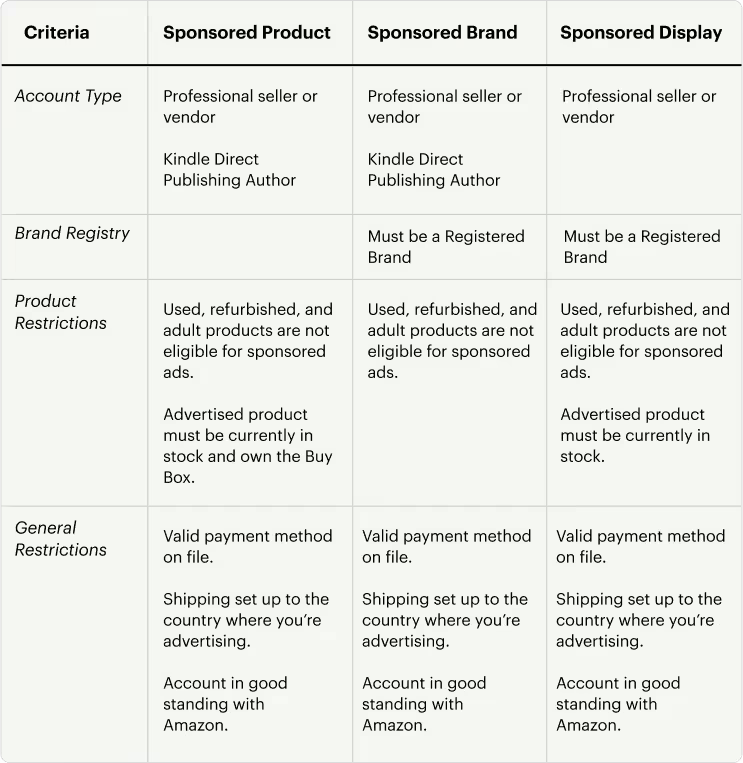
As you likely noticed, you’ll need to trademark your brand and join the Amazon Brand Registry to explore ads beyond Sponsored Product Ads.
Important Amazon PPC KPIs
The last piece of information you need before you move on to setting your goal and strategy is knowing what metrics to track and how to do so effectively. When running ads on Amazon there watch the below key performance indicators or risk wasting your budget with little growth to show for it.
You need to look at:
- Current budget
- Net profit
- Cost per click (CPC)
- Click-through rate (CTR)
- Conversion rate (CVR)
- Advertising cost of sales (ACoS)
Let’s quickly look at each metric in-depth.
BUDGET
You need to know how much you can spend for your client acquisition on each individual product that you are selling. It’s a must.
Your budget will evolve as your sales grow, and you learn what it costs to get a sale, but for each campaign, you need to determine your current budget. For some campaigns, like a brand awareness campaign, it may be most of your profit, but it may be more conservative for other campaigns.
Determine the difference between the cost of your product along with storage, packing, and shipping cost and your listing price. Next, figure out the minimum amount you’re willing to accept as a profit for each sale.
At that point, you have an idea of your overall campaign budget and the maximum you can afford to pay for each sale.
NET PROFIT
Your budget looked at the product listing price minus product costs, but now we’re adding in the PPC costs as well.
Calculating your net profit is absolutely necessary if you care about profit (and, let’s face it, who doesn’t?).
You need to calculate your net profit after deducting your advertising ad spend.
Here’s the formula to calculate it manually:

So, calculate your budget pre-campaign and calculate your net profit as you learn the advertising costs.
CPC
By further breaking down each element of your customer acquisition – cost per click, click-through rate, and conversion rate – you can quickly identify any problem area that’s driving up your overall costs.
Amazon will report these metrics to you, but it’s always useful to understand how to calculate the metrics yourself, so you fully understand their importance.
You can calculate your cost per click by dividing your total spend by the number of clicks on the ad.
If you have a high CPC, you know something is probably off with your keywords or other targeting. Your CPC can also be driven up by targeting the more competitive keywords before your product listing has built up sales and reviews.
CTR
You calculate your click-through rate by dividing the number of click-throughs to your product page by the number of impressions or views it received.
Similarly to the CPC, your CTR can be impacted by poor keyword targeting and low reviews on a competitive product. Compare how your listing looks next to the organic listings of similar products. Is the title descriptive enough and match the other listings? Does your main product photo look professional? If your ad looks bland compared to the other listings, your CTR is going to be low.
CVR
Since Amazon focuses on clicks over impressions, your conversion rate is the number of purchases divided by the number of clicks.
If you have a high CTR but a low CVR, you need to focus on improving your product page. When shoppers are clicking through, it shows that your keywords and title are working, but something further in the funnel isn’t. You can start by investigating the high-performance listings in your category and determine what those listings have that you don’t.
ACoS
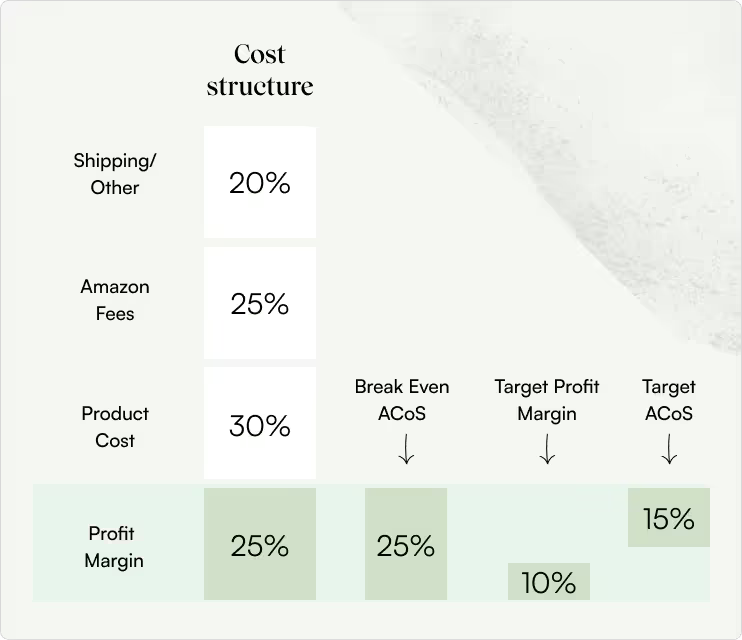
If you want to increase your daily sales with Amazon PPC, you need to know your breakeven ACoS. And if you have multiple products, then you need to know your break-even ACoS for all of them.
ACoS is simply your ad spend divided by revenue generated from ad spend times 100 to get a percentage. ACoS will vary across product categories, but 30% is the estimated average.
Say your break-even ACoS is 25%, and you want a 10% profit margin. This means you have 15% to spend on paid advertising.
Make sure you are not overspending or over-testing keywords with your paid advertising campaigns and turn off keywords/ads that do not hit your target ACoS.
Without clearly defined KPIs, it’s going to be challenging to manage and optimize your campaigns profitably. Amazon isn’t a platform you can set ads up on and walk away. You need someone managing your campaigns.
Search Term Report For Evaluation
When you’re evaluating your KPIs, you’re going to need some information from Amazon. Most of the information you need can be found in the Search Term Report.
To download the report, you’ll want to:
Step 1: After you log into your Seller Central account, navigate to the Reports tab.
Step 2: Click on Advertising Reports and then Create Report.
Step 3: You’ll then select your Campaign Type.
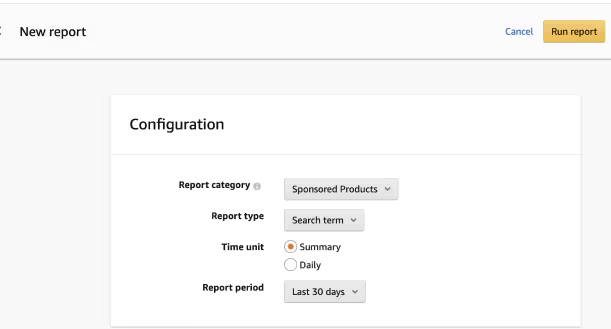
Step 4: Finally, select the Search Term report, outline the time frame, and Run Report.
Setting Campaign Level Goals
It’s time to move on to setting your campaign goals. Having goals is vital for every marketing campaign.
You can set your goals using this formula:

In general, any time you are trying to build up your visibility – and sales – you will have a lower profit margin. It’s part of growing a product. That’s why you have to know your breakeven ACoS to ensure you don’t lose money in the process.
But once you start having higher sales volumes, you’ll want to focus on how to improve your profit on each sale. That’s when you aim for your target ACoS.
It’s worth noting that every campaign will have its own ACoS. This is because the ad spend it takes to get a sale for one product is not the same for the next. More than that even, as you move from targeting lower volume keywords to the more competitive broad keywords, your ACoS is likely going to rise. But the added sales may make up for the higher costs.
Ultimately, every campaign needs to be run with the end goal in mind while keeping profitability in mind.
Creating An Amazon PPC Strategy
So, let’s quickly review the steps to getting started with Amazon PPC before we move to actionable strategies you can test.
1. Choose an ad type. Sponsored Product Ads are the best place to start, but you can expand into other ad types if you are on the Brand Registry.
2. Decide between an automatic or manual campaign. If you opt to start with a manual campaign, be sure you’ve developed a comprehensive list of keywords. Start with long-tail keywords for new products and move to broader keywords as your listing grows.
3. Determine if additional targeting is needed for the campaign. If so, find the right ASINs or category.
4. Understand your budget and what bid you are comfortable with. Be sure to consider if you will use placement modifiers. You should only add them after running the campaign and have concrete results you can base your decision on.
5. Run your campaign for two weeks, then evaluate the results. Start looking for potential negative keywords to add and opportunities to pull high-performing keywords into their own campaign.
6. Continue to run and refine your campaign to improve ACoS. Pull your Search Term report at least once per week.
And those are the basic steps to get started with Amazon PPC. As you get more familiar with the advertising platform, though, you’ll want to incorporate more strategic decisions.
There are both beginner strategies that are simple enough to use when you’re new or advanced strategies for later to stimulate listing growth.
Beginner Strategies on Amazon PPC
As the old saying goes, you need to walk before you can run. You need to confidently run a campaign using beginner strategies before you take on anything more advanced. So, what are some beginner strategies you should use?
MIX UP YOUR ADVERTISING GOALS
It isn’t easy to juggle multiple campaigns with varying goals, but it’s the next step in your advertising journey.
We recommend advertisers use a combination of brand search ads, prospecting ads, proven to work ads.
So if you have 1 product that you would like to advertise, then your setup is going to look like this:
- Brand search campaign that targets your brand keywords
- Testing campaign – manual campaign with different keywords that you are testing with broad/phrase match.
- Proven to work campaign – manual campaign with keywords proven to work well for your product with exact match.
- Automatic campaign.
Exclude your proven to work keywords + brand related keywords for your automatic campaign.
You need to know where you are testing and where you are scaling your profitable ads on Amazon.
Having a clearly defined structure will help you to make more sales on a higher ROI.
START WITH LONG-TAIL KEYWORDS
When looking for keywords, you may be inclined to choose the keywords with the highest search volume. Why wouldn’t you want to get in front of the most shoppers, right?
Well, because more searches mean more listings. And short keywords are also more prone to browsers than buyers.
New listings need to find an audience that’s ready to buy without tons of competitor listings in the way — that’s where long-tail keywords come in.
Let’s go ahead and look at an example.
When I entered “women’s scarf” in the search bar, there was no shortage of promoted listings with solid reviews. Plus, the scarves are all over the place in terms of design and materials, so who knows exactly what the shopper is looking for. As a result, it’s going to be difficult to stand out.
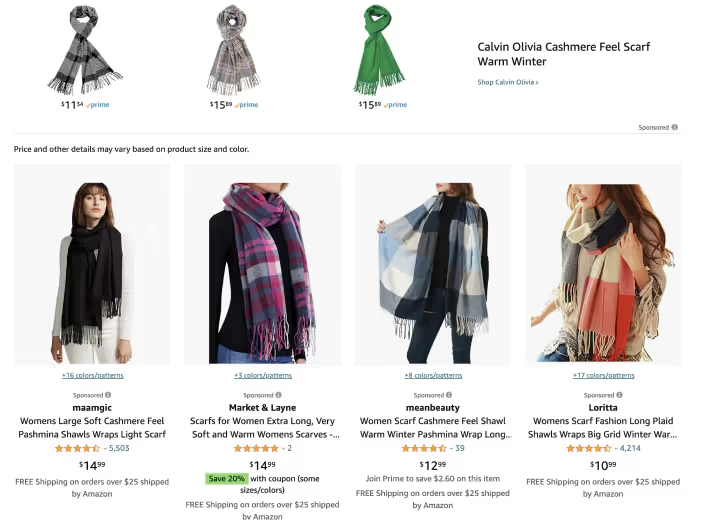
But for my next search, I went long-tail. I decided I was looking for a “women’s gray cashmere scarf.”
What do you notice? For one, the products have far fewer reviews. You’ll also notice that listings with premium pricing actually stand a chance, which wouldn’t have been true with the first search.
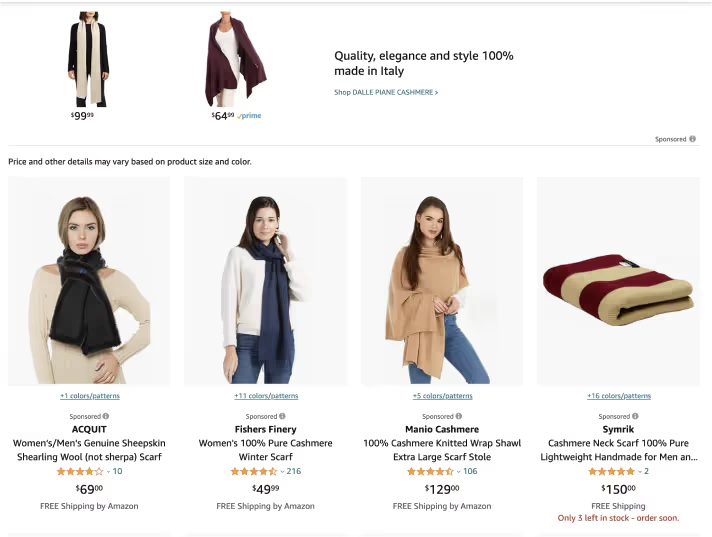
And because the shopper knows exactly what they want, they’re more likely to purchase it once they find it instead of falling down a rabbit hole of products and not making a decision or being swayed in a different direction.
For beginner sellers, or sellers looking to compete on more than price, long-tail keywords are a top strategy to try.
IMPROVED ADS > NEW ADS
As you’re running your campaigns, you need to know how to make minor tweaks that get big results. Generally, there’s no need to start over with a campaign.
Instead, look at your metrics and use them to guide your next move.
Organize daily, weekly and monthly optimization for your Amazon PPC campaigns. Even if you are on a tight budget, you should focus on spending your budget only on keywords that make sense and hit your target ROI.
When reviewing your campaigns, you want to make sure that you are not making decisions quickly.
We recommend watching your campaigns data day-to-day to understand how your campaigns are performing and what optimization they need when you first start.
Here are a few of the optimizations that we do in our client ad accounts:
1. Review the data on Automatic campaigns
Once we see how automatic campaigns work, we will analyze the top converting search terms and transfer them from automatic campaigns to manual campaigns with best-performing keywords.
Then we will exclude these keywords from the automatic campaign (since we will be bidding on them in the manual campaign), and we want to avoid keyword overlap.
You want to make decisions based on the data, so you only add keywords that meet your target ACoS.
2. Use negative keyword mining.
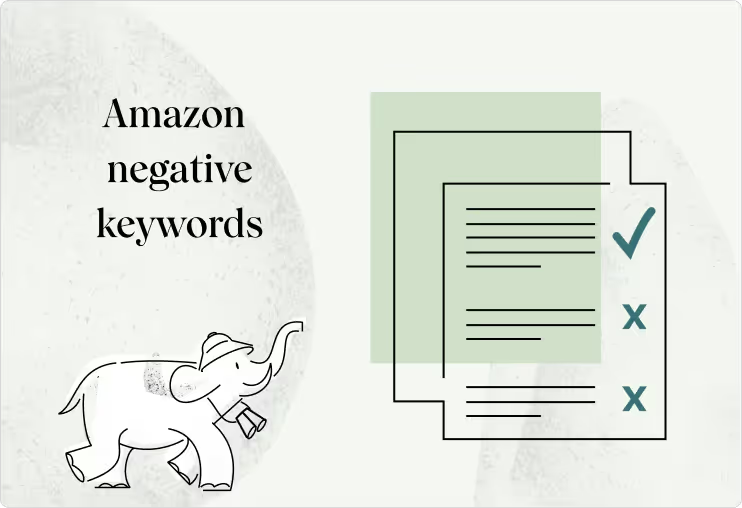
Analyze your campaigns every week and remove search terms that do not meet your KPIs.
Apply negative keyword mining to all of your campaigns every week and turn off keywords and search terms that are spending your money without driving sales on the target ROI/ACoS.
If you have search terms or keywords on breakeven/near breakeven, leave them active for another week and make a note to review these keywords/search terms again next week.
You should also review for irrelevant search terms that are not relevant to your product.
And you should also double-check and make sure that all irrelevant search terms are removed.
Remember, you don’t have to win all auctions to be profitable with Amazon PPC.
Focus on winning auctions that are proven to work well for you and spend the majority of your marketing budget on them.
3. Optimize your placements for all of your Amazon PPC campaigns
A commonly missed opportunity for optimization is Amazon Placements modifiers that most advertisers overlook.
Why? We have no idea.
Should you optimize your placements?
Yes, you should.
4. Optimize your CPC bids
Based on your data, you have to optimize your Amazon CPC bids.
If you are not spending your daily budget, you could increase your bids by 10-20% and watch the data closely. If you are still not hitting your desired daily ad spend, you should increase your bids again or add more keywords.
If that doesn’t help, you will need to do keyword research and look for missed opportunities.
When reviewing your data, it’s essential to keep in mind your conversion rate too.
For example, if your CPC bid is $5 and you spend $500 to get ten clicks but convert only 10% of the traffic for a product that is $50, you won’t be profitable (recently, we had a case like that).
What data showed us in the example above?
CPC BID was $5 x 100 clicks = $500 ad spend = 10 sales x $50 (per product) = $500 Revenue = ROI 1.0 and conversion rate of 10% (pretty standard for Amazon).
We started to drop our bids by 10% a day and experiment with more keywords.
Two weeks later, we increased our client ROI up to 2 by applying negative keyword mining, decreasing bids, and testing more keywords.
Advanced Amazon PPC Strategies
Now that you’ve started to dig deeper into Amazon PPC, it’s time to talk about a few more advanced strategies.
AMAZON CAMPAIGN STRUCTURE
Most of the advertisers on Amazon never heard about Amazon single ad group campaigns.
We find that setup to be optimal since you can have complete control over the PPC environment.
Here is an example of a structure:
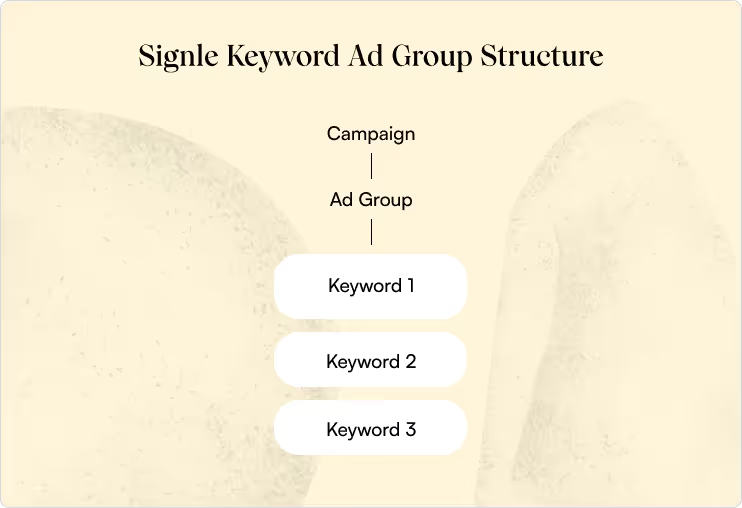
Using this campaign structure gives you more control over the performance and budgeting of your ads. It also makes it easier to track individual metrics and adjust pieces of your campaign as needed.
However, it’s important to note that we use this method for scaling purposes only because you need to have some foundational knowledge – high-performing exact and phrase match keywords – to successfully create the structure.
CUSTOMIZE YOUR STRATEGY BASED ON RANKING
Hopefully, you’ve started to see your product listing move up in the results for your target terms.
But did you know that your PPC strategy needs to pivot based on how your product is ranking?
When your product is on page 5 or further in the results, your ads are exploratory. You’re looking for keywords that can get you more sales and reviews. The focus is on improving your positioning as quickly as possible for later. This is the learning phase.
However, as you start to find your product on pages 3 or 4, you enter the building phase. It’s time to start expanding into keywords with a larger reach in addition to getting the conversions with your keywords that are already working.
Finally, when your product listing is on page 1 or 2 of the search results, it’s time for growth. You need to double down on your efforts. This is your chance to slip into one of the coveted top spots. The majority of your budget should be focused on that goal while keeping a small budget running for your backup keywords.
Troubleshooting Amazon PPC Campaigns

WHY ARE MY AMAZON PPC ADS NOT SHOWING?
Amazon wants to keep its shoppers happy. Part of that is putting listings in front of customers that get them to click through, and hopefully, make a purchase.
If your ad has been shown to a fair amount of shoppers with no clicks, Amazon will stop putting your ad in front of as many people because they assume it’s not what they want.
The answer is to make your ad as relevant as possible to your target audience. You need to consider if you may be categorizing your product incorrectly or if you can try another angle to market your listing.
Competitor research should have been done before you started selling, but if it wasn’t, look at similar listings and get a feel for what they’re doing successfully. Also, evaluate the ads you’re competing against to find potential areas of improvement. The only real answer to your problem is tweaking and testing.
WHY ARE MY AMAZON PPC KEYWORDS GETTING LOW IMPRESSIONS?
If your ad isn’t getting impressions, it’s probably not getting shown or the audience you’re targeting is too small.
Finding the right keywords for your campaign is a process. You can do keyword research and get off to a good start, but you won’t have definitive results to base your choices on until the campaigns start running.
The worst thing you can do is keep throwing your budget at keywords that just aren’t working. Always be on the lookout for better options.
Start by doing the opposite of what you’re currently trying. For example, if you’re going after the high-volume keywords, switch to hyper-specific long-tail keywords and vice versa.
HOW DO I KNOW IF MY AMAZON BID IS TOO HIGH?
Bidding is fickle, and the right bid will depend on the keywords, ad placement, and even the time of year you are running the campaign.
Amazon gives a suggested bid. It is unclear exactly where the “suggestion” is coming from. But since Amazon wants advertisers to make money on its marketplace, the suggested bid is likely positioned almost to guarantee you win.
But this also means it may be a higher bid than is necessary.
The best place to start is bidding near the suggested bid and continuing to test bid amounts with different keywords and placements until you find your sweet spot.
AM I USING THE WRONG AMAZON AD PLACEMENT OPTION?
There are no hard and fast rules for which placement you should choose. You’ll have to test and measure the results based on your goal.
You’ll also need to consider your product. If it’s an accessory to another product, your best bet is to test advertising on product pages. On the other hand, if your product improves an already popular product, you may want to test the top of the search results first.
Your next step is to thoroughly review the Placement report provided by Amazon.
Don’t forget, Amazon allows you to adjust bids by placement type so you can focus more of your budget on the placements that work for your product once you look at the results.
WHY ARE MY AMAZON CTR AND CVR SO LOW?
Optimizing your Amazon listing is one of the fundamental elements to make more sales with the platform.
Your product listing must be optimized for higher CTR (click-through rate) and CVR (conversion rate).
There are three optimizations to focus on.
#1 Keyword optimization: Adding all relevant keywords for your product. Make sure you are not missing keywords that a customer might type.
#2 Content optimization: Adding high-quality pictures and writing direct-response copy for your product description.
#3 Product offer: Compare your pricing to your competitors and see if this could be a potential reason why your conversion rate is lower.
You might be thinking Amazon PPC seems too complicated to learn, and you’ll just give it a go without paid advertising. But I’d advise you to understand why you can’t avoid running campaigns if you want to grow a successful Amazon business.
3 Reasons To Use Amazon PPC
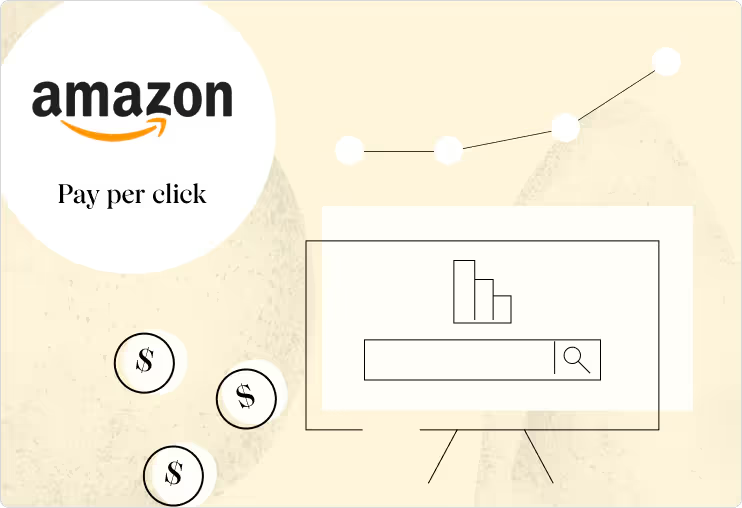
The bottom line is without using Amazon PPC, it’s going to be extremely difficult to get to the first page of the search results for any product with a decent-sized market.
1. Build your brand.
Building an Amazon brand isn’t easy. You can’t just add some product listings and have people flock to your listing.
Unless you’ve created a completely unheard-of product, you’ll have competitor brands already occupying the top spots. And if you do have a new, novel product, you have the difficult task of getting your customers to know you exist.
In any case, you’re going to have to build a brand to become more than another seller on Amazon with no customer loyalty.
Paid advertising is how you get in front of your prospective customers from day one. Without it, you may never see the top of the search results, which is, of course, where the sales are.
2. Stay ahead of the competition.
As we just covered, competition doesn’t disappear when you join Amazon. Even if there isn’t a household name in your space, there are potentially tens to hundreds of other start-up brands vying for the best position.
What happens if a handful of them invest in Amazon PPC and you decide to try to go the strictly organic route? You probably guessed it; they’ll take some of your customers.
People are always looking for the next best thing, and when you don’t stay top of mind, it makes it easy for the competition to sneak in.
3. Lift your SEO efforts.
The easiest way to get more sales on Amazon is through Amazon PPC (pay-per-click) ads. Combining PPC and Amazon SEO going to help you to make more money with your store.
When created and managed properly with daily, weekly, and monthly optimizations and systems in place, Amazon PPC campaigns can help you sell more products at a faster rate and increase your organic rankings.

If you are trying to improve your organic ranking, you have to do PPC.
Paid advertising on Amazon will get you more sales, and the more sales generated will have a positive effect on your organic product ranking. Basically, the more sales you make, the higher you will organically rank.
So, you have to get consistent daily sales to rank higher and receive a higher organic traffic share.
The best sellers on the platform focus on both PPC and SEO. And, fortunately, an Amazon PPC expert can help you compound paid and organic growth if you’re struggling.
Amazon Growth Case Study
How COCOSOLIS boosted their Amazon sales by 541% in the first year of working together in Amazon

When Alex Stoykov, CEO & Account manager at Olifant Digital, met with Plamen Stefanov, CEO at COCOSOLIS, they discussed the best ways to boost sales on Amazon US, DE, UK, FR, IT.
The services offered by Olifant Digital are:
- Amazon PPC Management across all markets
- Conversion Rate Optimization
- Ranking campaigns
The PPC accounts we’re disorganised and in a big mess with a mixed prospecting and brand search campaigns, auto campaigns that were running for years without negatives, no video ads, and manual campaigns with multiple ad groups in the same campaign. Olifant Digital had to rebuild the account and the management of their entire Amazon store in order to allow the brand to grow.
We had to work closely with the COCOSOLIS team in order to obtain better information about their brand and their target goal. The brand wanted to grow and focus on a few seasonal products. Based on their goal we crafted a custom marketing strategy that will allow us to dominate in the summer season for the products they want to sell and have the most stock.
In 2020-21, we were able to grow the brand with more than 541% on Amazon and scale to 7 figures.
Our client goal was to scale with about 150% per year. We achieved 541% growth in the first year of working together.
Our next target and goal is to launch more products on Amazon and build a diversified portfolio with products for the summer and for the winter so we can hit high numbers on a month-to-month basis.
Getting started with Amazon PPC is overwhelming, especially if you’re also new to selling on Amazon.
Instead of wasting your advertising budget trying to teach yourself the ins and outs of Amazon campaigns, you can partner with an agency that knows how to get results.
At Olifant Digital, we routinely help our clients optimize their campaigns and grow their brands.
We start with a full audit of your current strategy, then develop a custom marketing plan based on your products and goals.
Want To Be Another Success Story?
Get your free marketing plan for us and see what we could do for you.
Keep in mind our marketing plan & audit is custom and professionals will be looking at your account and thinking what is the best next step for your brand based on your goal.
During the free marketing plan our team will show you the following:
- Discuss your business goals
- Craft custom marketing strategy for your brand
- Show how our expertise can help your growth
Click here to get your free Amazon growth marketing plan.














.webp)

.webp)








.webp)










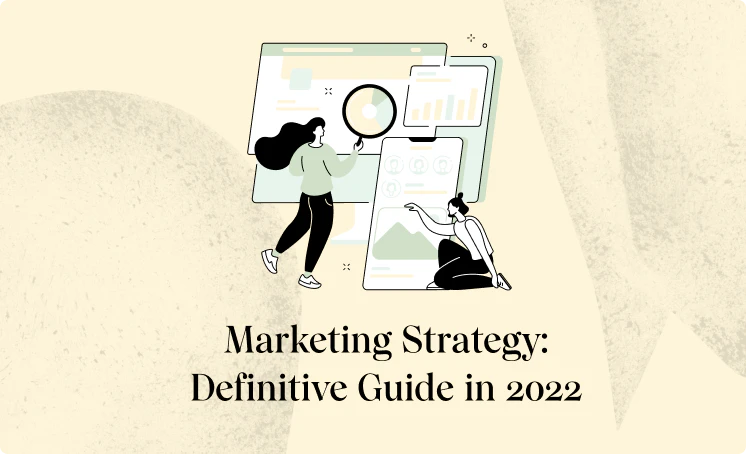

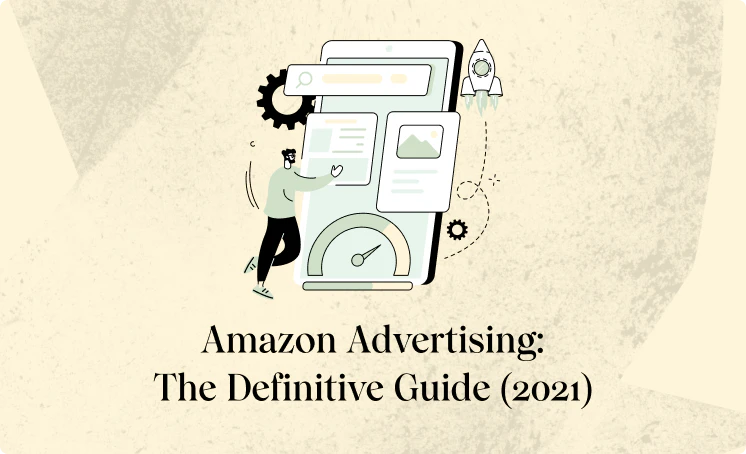





























.webp)





